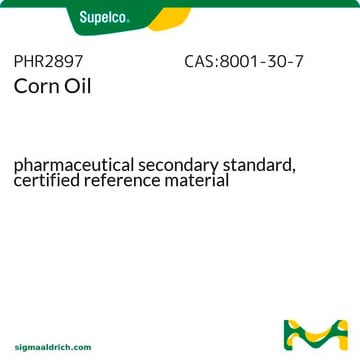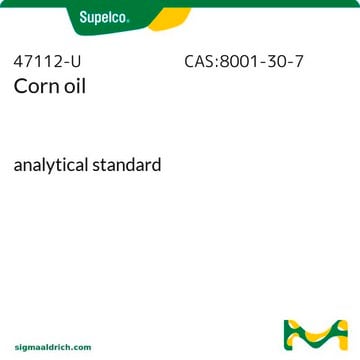This product is stored at room temperature. While refrigeration is not necessary, temperatures of 2-8°C will not be detrimental.
C8267
Aceite de maíz
delivery vehicle for fat-soluble compounds
Sinónimos:
Aceite de maíz
Seleccione un Tamaño
53,50 €
Seleccione un Tamaño
About This Item
53,50 €
Productos recomendados
origen biológico
maize
Nivel de calidad
Formulario
liquid
color
very faintly yellow to yellow
densidad
0.9 g/mL at 25 °C (lit.)
aplicaciones
life science and biopharma
sample preparation
grupo funcional
ester
tipo de lípido
oils
Condiciones de envío
ambient
temp. de almacenamiento
room temp
¿Está buscando productos similares? Visita Guía de comparación de productos
Descripción general
Aplicación
Características y beneficios
- Puede utilizarse en investigación en metabolómica, bioquímica y formulación
- Compuesto de gran calidad adecuado para múltiples aplicaciones experimentales
Otras notas
Código de clase de almacenamiento
10 - Combustible liquids
Clase de riesgo para el agua (WGK)
awg
Punto de inflamabilidad (°F)
489.2 °F - open cup
Punto de inflamabilidad (°C)
254 °C - open cup
Equipo de protección personal
Eyeshields, Gloves
Elija entre una de las versiones más recientes:
¿Ya tiene este producto?
Encuentre la documentación para los productos que ha comprado recientemente en la Biblioteca de documentos.
Los clientes también vieron
-
Hi, I was wondering if its possible to confirm the storage condition for corn oil (C8267) ? Is corn oil stable in the fridge? Thanks
1 respuesta-
¿Le ha resultado útil?
-
-
How can I determine the shelf life / expiration / retest date of this product?
1 respuesta-
If this product has an expiration or retest date, it will be shown on the Certificate of Analysis (COA, CofA). If there is no retest or expiration date listed on the product's COA, we do not have suitable stability data to determine a shelf life. For these products, the only date on the COA will be the release date; a retest, expiration, or use-by-date will not be displayed.
For all products, we recommend handling per defined conditions as printed in our product literature and website product descriptions. We recommend that products should be routinely inspected by customers to ensure they perform as expected.
For products without retest or expiration dates, our standard warranty of 1 year from the date of shipment is applicable.
For more information, please refer to the Product Dating Information document: https://www.sigmaaldrich.com/deepweb/assets/sigmaaldrich/marketing/global/documents/449/386/product-dating-information-mk.pdf¿Le ha resultado útil?
-
-
How is shipping temperature determined? And how is it related to the product storage temperature?
1 respuesta-
Products may be shipped at a different temperature than the recommended long-term storage temperature. If the product quality is sensitive to short-term exposure to conditions other than the recommended long-term storage, it will be shipped on wet or dry-ice. If the product quality is NOT affected by short-term exposure to conditions other than the recommended long-term storage, it will be shipped at ambient temperature. As shipping routes are configured for minimum transit times, shipping at ambient temperature helps control shipping costs for our customers. For more information, please refer to the Storage and Transport Conditions document: https://www.sigmaaldrich.com/deepweb/assets/sigmaaldrich/marketing/global/documents/316/622/storage-transport-conditions-mk.pdf
¿Le ha resultado útil?
-
-
Is this oil stripped of any natural emulsifiers like lecithin or are there still possible residues?
1 respuesta-
This product may contain some lecithin (also known as Phosphatidylcholine). This item is not tested for lecithin levels.
¿Le ha resultado útil?
-
-
Dans quel contenant est stockée l'huile (inox/plastique/teflon/verre) ?
1 respuesta-
This product is packaged in an HDPE bottle with a polypropylene screw cap and a PTFE liner.
¿Le ha resultado útil?
-
Filtros activos
Nuestro equipo de científicos tiene experiencia en todas las áreas de investigación: Ciencias de la vida, Ciencia de los materiales, Síntesis química, Cromatografía, Analítica y muchas otras.
Póngase en contacto con el Servicio técnico









